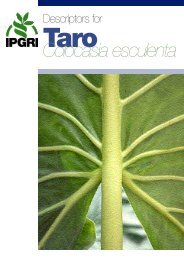Download PDF (6215 kb) - Bioversity International
Download PDF (6215 kb) - Bioversity International
Download PDF (6215 kb) - Bioversity International
You also want an ePaper? Increase the reach of your titles
YUMPU automatically turns print PDFs into web optimized ePapers that Google loves.
The European Poa Database 14<br />
EUROPEAN CENTRAL FORAGES DATABASES 33<br />
Manager: Evelin Willner<br />
IPK-Genebank, Aussenstelle Malchow, Malchow/Poel, Germany<br />
URL: http://www.dainet.de/genres/eccdb/poa/poa.htm<br />
In the European Catalogue of Poa, 12 institutes from nine countries with a total of 2636<br />
accessions are listed (Table 1), as a result of the recent updating of the European Poa<br />
Database. Letters requesting Poa passport data were sent to 26 institutions in 19 countries<br />
holding relevant germplasm.<br />
Until 1995, the European Poa database was maintained by Dr L. Seidewitz at BGRC<br />
Braunschweig. In connection with his retirement, and according to a decision of the<br />
ECP/GR Forages Working Group in 1995, the responsibility for maintaining and updating<br />
the Poa database was transferred to the Genebank for Oil and Forage Crops in<br />
Malchow/Poel, which is part of IPK's genebank. Dr Seidewitz sent a copy of the database<br />
and some updates which he had received but not yet incorporated, to Malchow in 1995. The<br />
former Poa Database arrived in a text format, where fields were delimited by '$ '.<br />
Data from institutions which had sent updates later were excluded from the 1995<br />
database. The remaining data (belonging to institutions from which no updates were<br />
received) were retained and transformed into the new structure.<br />
Other data received from contributing institutions (updates and/or new contributors)<br />
arrived in different formats, mainly .dbf (dBase or FoxPro), .xls (Excel) or ASCII files of<br />
various structures. They were transformed into a unique format, which was developed<br />
based on earlier recommendations of the ECP/GR Forages Working Group (Guide to<br />
ECP/GR Forages Databases; 1991) and the IPGRI Multicrop Passport Descriptors (Draft of<br />
January 1997). The actual descriptors included in the new Poa database were chosen<br />
according to the descriptors present in the data files of contributors. Some of the original<br />
fields were put together into one resulting field, for example, different fields describing<br />
different aspects of the habitat of the collecting site. Information which could not easily be<br />
assigned to any field from the proposed structure was put into a 'Remarks' field.<br />
No attempt was made to standardize names of institutions which appear mainly in the<br />
fields 'Donor', 'Breeding Institute' or 'Collecting Institute'. The variety of formats and the<br />
level of detail of this kind of information in the original data files was so big that it seemed<br />
impossible to standardize such acronyms in the time available. A new version of the FAO<br />
list of institute acronyms (author: J. Serwinski) was not yet available. In addition, often the<br />
information about such institutions is incomplete (e.g. only the name of a person, or the<br />
town, without further details), and such incomplete data cannot be linked to any existing list<br />
of addresses. Often even the institute providing such data will not be able to give more<br />
complete information.<br />
Neither was it possible to standardize the scientific names. Only the spelling of scientific<br />
names was standardized, and authors were added in cases where the same name appeared<br />
with and without author in the database. In cases where the name appeared only without<br />
author, no attempt was made to identify the author. This could be done later. The<br />
accessions included in the database belong to 27 different species, the most frequent being<br />
Poa pratensis with 2376 accessions, followed by P. bulbosa (68) and P. nemoralis (35).<br />
14 Report by H. Knüpffer (IPK-Genebank, Gatersleben), S. Harrer (ZADI/IGR, Bonn), and E. Willner.




